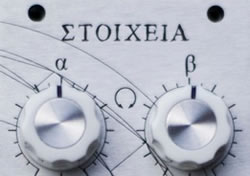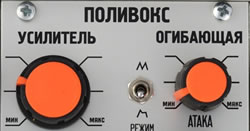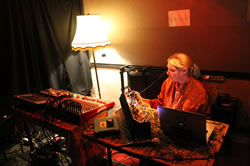An Artist’s Approach to the Modular Synthesizer in Experimental Electronic Music Composition and Performance
Held in Manchester from 24–26 October 2014, the first Sines & Squares Festival of Analogue Electronics and Modular Synthesis was an initiative of Richard Scott, Guest Editor for this issue of eContact! Some of the authors in this issue presented their work in the many concerts, conferences and master classes that comprised the festival, and articles based on those presentations are featured here. After an extremely enjoyable and successful first edition, the second edition is in planning for 18–20 November 2016. Sines & Squares 2014 was realised in collaboration with Ricardo Climent, Sam Weaver, students at NOVARS Research Centre at Manchester University and Islington Mill Studios.
I dream of instruments obedient to my thought and which with their contribution of a whole new world of unsuspected sounds, will lend themselves to the exigencies of my inner rhythm. (Edgard Varèse cited in Holmes 1985, 116)
Musicians have always had aspirations to communicate in other forms of language. Since the earliest days of the electromechanical era, discoveries and research in electronics made possible the development of new instruments and technologies — radio waves and telecommunications, amplification and the phonograph — that afforded the means to create new music and new musical practices; what had previously been inexpressible for musicians could now be expressed. The progression of fascinating discoveries has led, among other things, to the complex world of synthesis, and now, before me is a machine that looks harmless, yet not at all simple, and has friendly, hypnotizing blinking lights. This machine is capable of infinite possibilities of sound design, more than most musicians can even comprehend.
I began composing electronic music in 2007 with a MIDI/USB controller and Ableton Live. VSTs were amazing for me at that time and being able to play them on a keyboard separate from the computer was immediately a rewarding activity for me. When I started my music technology degree in 2011, I was introduced to the world of Max/MSP. Initially, I found it confusing to patch in a programming interface, to understand the language, the numbers and the routing possibilities. While writing a paper on Morton Subotnick’s synthesis techniques for his album, Silver Apples of the Moon, I found myself referencing The Science of Sound textbook, trying to understand VCOs, VCFs and VCAs. Never having actually seen a Buchla synthesizer at that time, it was difficult to fully comprehend how this instrument built with those technologies — both of which I was unfamiliar with — could make that music. VSTs and MIDI were useful for me as a beginner, and without them I could not have evolved into the analogue modular synth fanatic I am today.

When I first saw the booths of the Eurorack companies at NAMM 2013, it was love at first sight. Something clicked in my mind and almost right away I understood that what I was seeing was a complex patch making beautifully strange sounds. Patching in Max/MSP became easier the more I began to comprehend the process of analogue patching. My journey into composing with analogue synthesis began in April 2013 when I received a Moog Sub Phatty as a gift from my father. That summer I ventured further into the DIY world of modular synthesis when I did a graduate internship, a requirement of my Master’s in music technology, at the 4ms Company in Portland, Oregon.
In my experience thus far utilizing the modular synthesizer as my most valuable tool to create textures, sounds and entire compositions, I have found that it is important to be semi-detached from the recording process to focus on the evolution of a patch, because it is nearly impossible to reach the same sound twice. Basically, after I begin a patch and it starts to sound interesting to me, I hit record and continue patching to capture the sounds that occur in the process. Half-hour or hour-long sessions of patching provide a world of sound textures. After my two-year excursion with my modular, and expanding it with the addition of new modules, I now have a surplus of recordings and an endless library of sound to sample. As I develop a patch by testing out the pathways of ins and outs and delicately changing the parameters, unknown sides of the modular are reflected through the sound and captured in the recording. It begins to lead the mind in the direction of the sound it wants to create!
From the beginning, I found the design æsthetic of modular components to be unique and interesting. Doepfer modules are greyscale and designed in terms of functionality. Other modular companies are using colour, artistic designs and even a sense of humour, with jokes inscribed on PCBs, and unconventional terms to describe their functions, like the “mayhem” oscillator output on Malekko’s “Anti-oscillator” module. As though modules are not cryptic enough, some are even written in different languages: Rebel Technologies, a London-based company, have the functions on the faceplates written in Greek (Fig. 1), and The Harvestman from Seattle has some written in Russian, my favourite at the moment being the Polivoks VCA/Envelope (Fig. 2).

Many companies are also creating their own language through symbols that serve as a visual guide. I believe that the intention of these artistic designs is to inspire a creative mind as well as technical, combining the right and left side of the brain affectively, for the composer and the engineer to find a middle ground. This customizable machine has the capacity to look as unique as it sounds when combining modules from different companies. There is an æsthetic to it, one of an otherworldly nature, giving the feeling that the machine has a life all its own. While conducting my research on the modular synthesizer, I have met and exchanged ideas with modular users and developers about the components that can be used in systems. The enthusiastic modular synthesis “community” is supportive and open-minded, innovative and almost alien to the rest of the world. The resurgence of modular synthesis is now occurring because more musicians are beginning to recognize its endless possibilities, each musician developing his/her own individual approach.
The sense of infinite combinations to create unique sounds is ever expanding due to these new designs, proving the extensive “soul” of the analogue sound, though some modules now contain DSP components as well as analogue. It is a perception of mine that these DSP implementations still have a different sound quality than VSTs, because they are being patched with analogue signals. The absence of labels on the inputs and outputs of some modules makes the process of patching a cryptic and surprising practice. The user must reference the manuals and remember the functions to create a new complex patch. Modular synthesis users know that patching can be a seriously demanding task, with only certain functions being predictable. When the patch becomes more complicated, experimenting with the different pathways, it can become extremely unpredictable. This is when the most exciting sounds are synthesized.
The modular allows a new art form, the technology as mystifying as the sounds and music it can potentially create. There is an ephemeral quality to the sounds of a complex patch, that it most likely can never be replicated the exact same way because of the sensitivity of the parameters. Modular synthesis gives the composer and the engineer the sense of exploration and discovery, communicating through the mystery of sound analysis.
Composing With the Modular Synthesizer
I am interested in the comparison of the voices of different modules and how they harmonize, experimenting with different possibilities and tunings of CV and FM. New chords are created when I patch three or four oscillator voices and tune them, paying close attention to the frequencies and counting the waveform pulses or beats accordingly. I spend a lot of time getting lost in the improvisational space while patching and actually playing the modular synthesizer. I then listen back to the recording and watch the waveform to choose my favourite sounds to then arrange in a composition. In my newest album, Invisible City, I use the modular synthesizer on every track to demonstrate its versatility and my own interpretation of the atmospheric sounds and moods it has the potential to create. In addition to sounds that resemble natural elements such as wind, rain and ocean waves, made using different colours of noise, and sounds that can potentially resemble acoustic instruments such as the xylophone, bells, drops and percussion, there are other mechanical sounds such as telephones, helicopters and sirens achieved through frequency modulation, voltage control and the envelope generator.
The modular synthesizer is capable of blurring the boundaries between real and synthetic sounds and has increased my sensitivity to all sounds in any given environment. I think of synthesis every time I hear a helicopter, and imagine myself panning the sound with my modular, or when I hear sirens, their pitch changing from the Doppler effect as they pass me on the street.
On the opening track of the album, Rory’s Eclipse, the main melodic line that is reminiscent of the telephone was sequenced using the Arturia BeatStep analogue sequencer. The rhythmic sound that is half a noise-like scream and half tonal is an oscillator with the CV modulating it. It has a melodic, mechanical quality that is only possible with the modular (Audio 1).
Explain to Igor is an excerpt from a pure modular jam I had in Berlin with my friend Igor who works at SchneidersLaden. We had a jam and compared systems and processes. Because Igor has a whole drum section in his system, this track has a notably different sound than others I have done (Audio 2). I do not have any of the Tiptop drum modules in my system but I enjoyed having a jam with Igor to see his approach to playing his modular. When I listened back to our jam in my studio, I edited the part of the jam that sounded seamless and made sense to me musically. I then added some Moog and recorded a long, tonal modular improvisation over it to tie it all together. All modular systems remind me of long lost friends, and they are happy when they get together to hang out and make sounds together.
Modular synthesis is capable of sounds that no other instrument can create, and for this reason it is important for composers and listeners alike — it creates the science-fiction æsthetic as a reality in soundscapes. Iannis Xenakis stated in his essay on “Creativity” that “the contribution of an individual depends on his originality, his own distinctiveness, even though he is caught in a global and general flux” (Xenakis 1991, 160). We seem to be experiencing another type of “global and general flux” with the ever-increasing popularity of modular synthesis and the exponential growth of new Eurorack modules. With so many possibilities, it becomes difficult to make compositional decisions, which is why my own methodology includes extensive experimentation with and analysis of modular synthesis sounds. Ultimately, we select our modules with a sound in mind that we intend to create with our modular systems.
The Futurists were the first to realize the relationship that was to develop between the musician and the machine throughout the 20th century. The following quote from The Art of Noises resonates with my own experience since I have started composing with the modular synthesizer: “We feel certain that in selecting and coordinating all noises we will enrich men with a voluptuousness they did not suspect” (Russolo 1967, 10). The Futurists’ analyses of noises are relative to the sounds with which I choose to compose. Russolo states in the Manifesto of Futurism:
Each noise possesses among its irregular vibrations a predominant basic pitch. This will make it easy to obtain, while building instruments meant to produce this sound, a very wide variety of pitches, half-pitches and quarter-pitches. This variety of pitches will not deprive each noise of its characteristic timbre, but, rather, increase its range. (Russolo 1967, 12)
This conclusion, which the Futurists were drawn to far before the advent of computers, is still widely relevant to experimental music, especially in the context of my own approach through experimentation with the modular synthesizer. Did the Futurists inspire the technological developments that were to come in the following decades? Control voltage now pushes the boundaries in modular synthesis, with the parameters of frequencies now being the determining factor of pitch.
Joanna Demers defines drone music by its absence of pulse, whereas in my new working composition, Int-son, inspired by Alessandro Cortini’s live performance of Sonno with the Buchla synthesizer at the Berlin Atonal festival (22 August 2015), I am using a slow rhythmic pulse to demonstrate the distribution of control voltage (Audio 3). Cortini’s performance in the large power plant was so loud that the sound and projection filled the entire space. I observed that the audience seemed contemplative in this peak festival time, the Saturday night at 10 p.m. With my composition, which I began working on the day after experiencing Sonno live, I aim to transmit the meditative listening state that I was in during Berlin Atonal. I find myself in this state regularly with the modular synthesizer while playing it in a live performance setting. I have noticed sometimes, while I am recording new sounds to use in the arrangement of the track I am currently working on, that I will get swept away in the sounds of the modular that go off focus and become something all their own. It is extremely difficult to compose with this instrument because of its unpredictability and intense sounds.
Live Modular Synthesis Performance

My live performance involves the playback of pre-arranged compositions on Ableton Live, utilizing rhythms, song structure and improvisation. Improvising with the synthesizer in a live performance allows a shock for the ears of the listener, hearing sounds out of the norm; it always raises a sense of intrigue in the audience. In my approach of testing out different pathways during live improvisation, I always reach new sounds in the moment, and they interact differently with how I, as the performer, interpret the sound and space. Sometimes during my performance, I start with a complex patch, and other times I patch from the beginning. At certain moments during the performance, the sound of the modular is breathtaking. I have to be careful when reaching certain frequencies not to cross the threshold of pain for the audience and myself. It varies for everyone but I know when I begin to feel it, usually when I am combining the features of subtractive and additive synthesis by utilizing the resonance peak on my filter module to create an alien or UFO sound. The pre-arranged compositions that I play back during the live performance remain as I had composed them, compressing hours into minutes as all music does, with the live modular synthesis being different every time.
The experience of performing live in Berlin (Fig. 3) was different than I found in many other cities. From what I could sense, the audience was listening closely and experiencing it more than talking over it. I have found the general support for new music and musical acceptance in Berlin is like nowhere else in the world.
My own experiments in sound design that I apply to my compositions are directly linked to the history of music technology with emphasis on analogue instrument formats, including the Moog synthesizer and Eurorack modules. A quote from David Tudor sums up my own interpretation of the sounds the synthesizer is capable of creating:
I try to find out what’s there — not to make it do what I want, but to release what’s there. The object should teach you what it wants to hear. (Cited in Collins and d’Escrivan 2007, 46)
The “object” in this case being one of great affection, my modular synthesizer has a personality that I can hear in the sounds it transmits.
Bibliography
Collins, Nicolas and Julio d’Escrivan (Eds.). The Cambridge Companion to Electronic Music. Cambridge MA: Cambridge University Press, 2007.
Demers, Joanna. Listening Through the Noise. New York: Oxford University Press, 2010.
Holmes, Thomas B. Electronic and Experimental Music. 1st Edition. New York: Charles Scribner’s Sons, 1985.
Rahn, John (Ed.). Perspectives on Musical Aesthetics. New York: W.W. Norton & Company, 1991.
Russ, Martin. Sound Synthesis and Sampling. 2nd Edition. London: Focal Press, 2004.
Russolo, Luigi. The Art of Noise. New York: Something Else Press, 1967.
sonicstate. YouTube video “Interview: Mr. Doepfer — King of Eurorack” (11:34) posted by “sonicstate” on 30 July 2014. http://youtu.be/F6vwlDIY8N8 [Last accessed 7 February 2016]
Xenakis, Iannis. “Creativity.” In Perspectives on Musical Aesthetics. Edited by John Rahn. New York: W.W. Norton & Company, 1991.
Social top